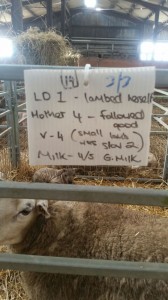CPT Lambing 2016
The first CPT lambs are beginning to hit the ground now. We are still in the very early stages of lambing with just 40 ewes lambed as of today Friday 4th. Over the next two weeks 2,000 ewes will give birth to progeny from our CPT rams.
The weather conditions are far from suitable to release lambs to the field, but with just 40 ewes lambed at this time there are more than enough individual lambing pens on farms to hold these sheep. On average each CPT farm will have in excess of 100 individual lambing pens. Ewes will soon need to move out of these individual pens. At this point ewes and lambs will have bonded sufficiently, lambs will be EID tagged, DNA sampled, weighed and scored for lamb vigour. Ewes will be scored for lambing difficulty, mothering ability and milkiness. All fostered, pet and dead lambed will be carefully tracked within the flock. All dead lambs are DNA sampled also and scored at birth. A reason for death is also recorded. Any incidences of prolapse, lameness, mastitis and anything else out of the ordinary is recorded at this time also.
Lambs are not tagged until they are dry and/or strong enough. This usually happens 12 hours after birth. However this means that data on each lambing event must be recorded at the point of birth in some way before it enters our data recording handheld 12 hours later. We have trialed many different ways to mark ewes and lambs at birth to ensure it is not lost before entering the handheld. By far the best method we have found for this is using small whiteboards on the front of each individual lambing pen. We use whiteboard markers on these pen boards which mean they can be re-used multiple times. When it comes to lamb tagging time 12/24 hours after birth it means all the required birth data is available for the person keying the data into the recording handheld.
See below some images from the different flocks involved in the programme this year.


record crucial information at birth.




